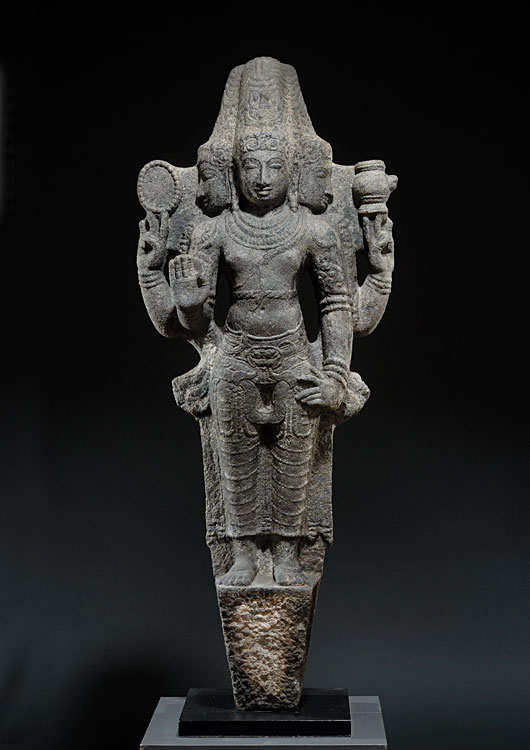

|
Brahma India, Tamil Nadu Chola, 11th century Granite height 138 cm. |

The trinity of Brahma, Vishnu and Shiva, representing the creative, preservative and destructive energies, forms the primary group of deities in the great system of Hindu gods and goddesses with all their countless ramifications. Creation began when the universal spirit wished to multiply itself. Out of kama (desire) originated the primeval male god Brahma, who in turn created the world and all life in it. Brahma embodies rajoguna, the quality of passion and desire and cause of creation. Having the power to create time and space, he is considered to be the ‘master of the universe’, and the source of all that exists. Brahma is depicted in a standing pose, wearing the sacred Brahmanical cord, or yajnopavita, across his torso. In his upper right hand he holds a rosary, in his upper left, a water pot. His lower right hand makes the reassuring gesture of abhayamudra, the sign of protection and fearlessness; his lower left hand rests on his hip. Three of his four faces, each of which represents one of the four Vedas, the ancient religious texts of the Indo-Aryans, are visible. The karandamukuta is made up of braids of hair piled up into a high crown-like arrangement and richly ornamented. The god is adorned with flowers above the ears, and with necklaces, bracelets, anklets, finger-rings, strings of pearls and ornaments. A makara, a mythical tutelary creature, occupies a central position in his girdle. The Cholas, one of the subcontinent’s greatest dynasties, came to power in the ninth century and ruled a large part of south India from their centre near Thanjavur on the south-eastern coast for a continuous period of about 430 years. They were very active patrons, fostering literature and the performing arts and building vast temple complexes decorated with images of the Hindu gods. This figure of Brahma exemplifies the Chola style in Tamil Nadu. The use of granite, which lends the carving a sense of immortality, is typical for the stone sculpture of this period. Intended to be shown frontally, the piece is unworked at the back. The shape of the mukuta, the necklace, bracelets and ornaments, are all typical stylistic traits. The hairstyle, with locks curling onto the shoulders, and the pronounced features, are likewise typical elements of the Chola style [1]. The Chola schools of art are among the highlights of Indian civilization, and Chola artists are renowned for depicting their gods with great skill and lively expression. This monumental stone Brahma is a pure and convincing representative of the Chola stylistic tradition. His sturdy upright posture, and rock-like stance contrast beautifully with the innate vitality of his limbs. The extremely fine facial features are especially noteworthy, enhancing his lively expression and rendering the iconographic meaning of ‘master of the universe’ in a superb manner [2]. [1] S. R. Balasubrahmanyam, Middle Chola Temples, Rajaraja I to Kulottunga I (985-1070), 1977, pl. 65, Nagapattinam, Karonasvamin temple; pl. 103, Madagadippattu, Kundanguli temple; pl. 216, Gangaikondasolapuram temple; pl. 237, Uttattur, Siddharatnesvara temple; pl. 296, Tiruppasur, Vachisvaram temple; and pl. 405, Tenneri, Kandelisvarar temple. [2] S. R. Balasubrahmanyam, Middle Chola Temples, Rajaraja I to Kulottunga I (985-1070), 1977, pl.1, a painting of King Rajaraja I (985-1014) in Tanjavur, Rajarajesvaram, exhibits fine facial features similar to those of the present sculpture. |